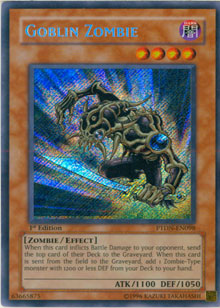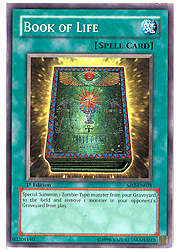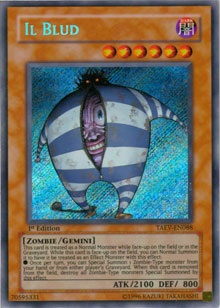The mid-format changes to the Advanced list blew the game wide open, allowing decks that were slightly underpowered to compete on the top levels again. One of the decks that gained a lot of playability, especially at a local level or within the Traditional format, was Zombies. Since the drawing power of Zombies is reliant on other cards, this deck wasn’t able to keep up with the three copies of Destiny Draw and Allure of Darkness the Dark Armed Dragon decks ran. However, with that deck wearing a leg brace since the loss of Dimension Fusion, an Allure of Darkness, and two copes of Return from the Different Dimension, the conditional speed of Zombies is enough to meet matches with the Dragon.
Once the Zombie engine starts working, it’s very difficult to stop. Even if your opponent has the cards necessary to clear your field, your hand will probably be so large that you’ll be able to refill the field the following turn. Once they start, they just won’t stop: the greatest benefit in moving this deck to the Traditional format is that it reaches that point much faster, meaning almost nothing short of Chaos Emperor Dragon - Envoy of the End will be able to stop you.
The Monsters
 The monster lineup is thin because you’ll be trying to work your way through the deck as quickly as possible. Also, Goblin Zombie helps you retrieve enough monsters to start any quick push you want to make.
The monster lineup is thin because you’ll be trying to work your way through the deck as quickly as possible. Also, Goblin Zombie helps you retrieve enough monsters to start any quick push you want to make.
As is almost always the case when playing a Zombie deck, you’ll be looking to special summon multiple monsters in a single turn using Il Blud or Zombie Master. This build is looking to abuse four total recruiting monsters: two copies of both Giant Rat and Pyramid Turtle. We’ll be using two copies of Creature Swap to exploit our monster choices and take control of our opponent’s powerhouse monsters.
The Spells
The spell lineup looks to draw cards as quickly as possible and rapidly load your field with five monsters. With Monster Reborn, Premature Burial, and three copies of Book of Life to complement the three copies  of Zombie Master and one Il Blud, you’ll almost always have access to your graveyard.
of Zombie Master and one Il Blud, you’ll almost always have access to your graveyard.
Instead of focusing on destroying monsters, you’ll be trying to take them instead. While the deck has Dark Hole and Raigeki, it runs a total of four cards that take control of opposing monsters. Perhaps the most powerful gain from movement to Traditional lies in the drawing power. The normal draw engines of the Traditional format are complemented by three copies of Card of Safe Return, which will help you cover any overextension you make. For every monster you special summon, you’re drawing a card. This means that a well-timed Mirror Force won’t lose you the game. The most impressive combo a Zombie deck can play is multiple copies of Card of Safe Return, which quickly leads to more special summons.
Perhaps the most remarkable card the Traditional format offers this deck is Painful Choice. Opening the game with one or more copies of Card of Safe Return and Painful Choice will open you up to special summon a third of the monsters in your deck. At that point, a single Monster Reborn or Book of Life on Il Blud could win you the duel.
The Traps
 The trap lineup looks to cover any early move you make involving Pyramid Turtle or Giant Rat. When Zombies first appeared on the Shonen Jump Championship radar, they ran three copies of Dust Tornado. This was justified by the fact that, while direct monster removal will destroy an opponent’s monster, destroying your opponent’s back-row cards and then attacking over a monster deals damage and destroys the monster as well. We’ll follow a similar logic here.
The trap lineup looks to cover any early move you make involving Pyramid Turtle or Giant Rat. When Zombies first appeared on the Shonen Jump Championship radar, they ran three copies of Dust Tornado. This was justified by the fact that, while direct monster removal will destroy an opponent’s monster, destroying your opponent’s back-row cards and then attacking over a monster deals damage and destroys the monster as well. We’ll follow a similar logic here.
Playing the Deck
You’re going to be very weak against any strategy involving remove-from-play cards, as you won’t be able to special summon from the graveyard when that type of effect is in play. However, you’re running Heavy Storm, Harpie’s Feather Duster, two copies of Dust Tornado, and three Solemn Judgment cards. If your opponent is playing Macro Cosmos or Dimensional Fissure, you’ll actually be a very strong favorite to win the game. If your opponent is running Banisher of the Radiance or D.D. Crow, you’re in trouble. For this reason, you’ll want to side deck some cards that can handle the situation for you. While stopping D.D. Crow is going to be difficult (and would have to involve some kind of hand control), Banisher of the Radiance can be stopped simply by running a monster with more than 1600 ATK. If you side deck Chiron the Mage, he’ll double as a way to stop both Banisher and Burn decks.
You can consider either main decking or side decking multiple copies of D.D. Crow yourself, to stop most popular decks.  Many players will be using the newly popular Dark Magician of Chaos one-turn KO deck, which wins the game by repeatedly tributing the Magician for burn damage and bringing him back with Dimension Fusion.
Many players will be using the newly popular Dark Magician of Chaos one-turn KO deck, which wins the game by repeatedly tributing the Magician for burn damage and bringing him back with Dimension Fusion.
Other than that, just try to cover all your attacks with a way to rebound if they are deflected. Ideally, this can be done by having Card of Safe Return on the field. You’re going to have to be even more careful when attacking with your Il Blud. Remember that when it is destroyed, all the monsters it has special summoned are destroyed as well. Don’t let your Il Blud turn your opponent’s Sakuretsu Armor into a Mirror Force! However, also remember that this is an aggressive deck. When testing this, you might notice that you’re forced to take bigger chances than you would if you played a deck more based on control. Remember, being a "perfect player" means assessing all your options, and choosing the right one given the information presented to you. Playing with this deck just might give you a better insight into the choices made by an aggressive duelist.
—Ryan Murphy